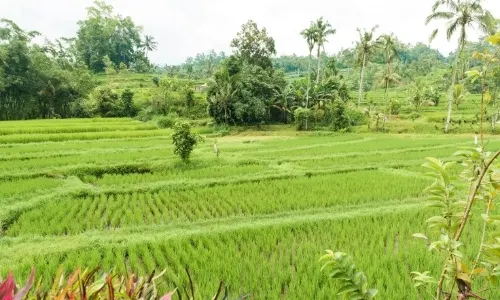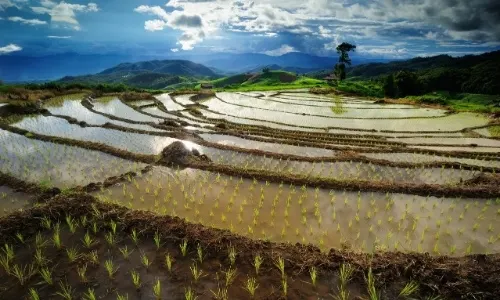Rice is such a common food item for so many folks it deserves its own show, really. But why does it grows in water?
Being a staple food, you’ll find it everywhere but what you’ll notice is the way it’s grown. Nearly every time a rice field is shown in movies, animes, or any work of art, it’s always a waterlogged rice paddy.
You may be very familiar with the flooded rice terraces that are so common in Asia.
So today we’re going to see just why rice is grown in water.

Why is rice grown in water ?
Rice is grown in water primarily to stave off pests, and keep weeds away from the rice fields. Neither weeds nor pests can survive in water for prolonged periods, but rice can.
This acts as a natural pest and weed control, without resorting to pesticides or herbicides.
That being said, not all rice is grown in water. Some can be grown as a dry crop like wheat, and we’ll get to explaining those in a minute.
Rice is an autumn/monsoon crop
This is pretty much the historical reason rice is still grown in flooded areas nowadays.
In the areas where it was first domesticated, the rivers would swell and flood the surrounding ares.
Farmers noticed the rice didn’t drown, but survived. The various weeds that grew around rice died off when the floods came, and the farmers observed this.
This led to the creation of rice paddies and rice terraces, which are regularly flooded.
Read Also:Why Is My Fried Rice Mushy ?
Weeds and pests don’t grow in water
The main reason weeds and pests don’t grow in water is because the water cuts off any oxygen supply.
Normally rice is planted in dry paddies, and allowed to sprout a few centimetres.
Then the paddies are flooded over the course of a few days, to simulate natural flooding patterns.
In some areas the rice is planted in already flooded paddies, when its sprout is tall enough to reach over its companion plant (Azolla).
Azolla is there to fix nitrogen into the atmosphere, so the rice can use it to grow. In return, it becomes the only other plant in the field aside from rice.
Any weeds that may have taken root will then die off, as will any insects or other pests that would try to ruin the crop.
As the weeds die off and decompose in the water, nitrogen is released into the water. This feeds the rice and acts as a fertilizer, and this is all kept under the shade of the Azolla plant.

dry rice paddy, before being flooded
Rice can be grown as a dry crop
It’s completely possible to grow rice as a dry crop, but there are more challenges.
As a plant, rice isn’t necessarily meant to be grown in water. Flooded areas aren’t where rice thrives and multiplies, but it can survive well enough if planted right.
Keep in mind that rice is planted from young sprouts that have already grown a bit.
Those sprouts come from dry crops, which are heavily controlled for pests and weeds.
And that is the problem with dry rice. You need a very large number of rice plants to harvest a large crop, so controlling the environment led to growing rice in water.
All that being said, we should take a look at the three main ways of growing rice, because they shed a lot of light onto the hurdles rice farmers have to tackle.
Paddy, deepwater, upland rice
As a crop, rice is crucial to billions of people. It’s the staple starchy food for Asia, North Africa, and a large part of the Arabian Peninsula.
That’s a lot of people, and those are only the ones who have it in their daily meals.
Throughout the ages rice has been cultivated in rice paddies, but there are other methods as well.
Rice paddies are regularly flooded
Rice paddies are the most common method of growing rice. They’re basically large bodies of shallow water that only grow rice.
You can find rice paddies all over Asia, at any elevation. Perhaps the most famous scenery in Asia is the one with rice terraces going up and down steep hills.
Those terraces are paddies, only at higher elevations. They function on the same principle as the field paddies: suffocate weeds by flooding the rice.
This is the oldest method of growing rice, actually. Ancient China is thought to be when and where rice was first domesticated.
In the middle and lower Yangtze river basin, at least 8500 years ago rice was first domesticated and grown according to wetland possibilities.
The rice paddy culture then spread to neighboring areas, including India, Japan, Taiwan, Philippines, Vietnam, and pretty much all of East and South Asia.

flooded rice paddy
Deepwater rice is grown in water over 50 cm deep
Deepwater rice is similar to paddy rice, but differs in water depth.
Where a normal rice paddy has shallow water (under 50 cm), deepwater rice is grown in water over 50 cm, often being at least 1 full metre, for at least 30 days.
This makes the problem of weeds virtually nonexistent, but not all rice can be cultivated like this.
Some special rice cultivars have been perfected over millennia to grow in high standing water.
The main thing that allows and actually helps rice grow to high is the fact that it produces ethylene. This gas needs to be released into the air, and this forces the plant to grow much taller as the water level rises.
Eventually, the rice will top the water and the ethylene will be released.
This kind of rice farming isn’t the most common, but it’s
Upland rice is a dry crop
The dry crop rice faces many more challenges than traditional rice paddies, and even deepwater rice.
Regular and thorough irrigation is needed for such crops, but they can easily fall prey to weeds and pests.
The uplands are notoriously infertile and are hit by droughts regularly. growing rice there is a challenge, but local farmers have found a way.
Researchers have developed rice types that can withstand droughts better, and have crossed them with the local species the farmers grow.
This resulted in better crops for the farmers, but weeds and pests are still a serious problem.
Read Also:Is Rice Flammable ?
Rice-fish systems
One development that came about around 1000 years ago is the rice-fish system.
It’s a symbiotic relationship between the fish and the rice plants.
The rice offers shade, a few insects that the fish can feed on, plenty of room to hide if the need to.
In return, the fish continuously move the water – rice doesn’t do well in fully standing, bog water. They also feed on the pests that may attack rice fields and also reduce a type of disease common in rice.
In short, both the fish and the rice benefit from being together and they’re becoming a common sight.
Not all rice is grown this way, and not all fish are beneficial.
For example carp, crayfish, tilapia, Chinese mitten crab, and the snakeskin gourami are on the approved list, fish that help the rice environment and pair well with it.
On the other hand, catfish, paddy eels and snakeheads threaten the balance of the rice-fish system and are on the pest list.
The main reason to grow fish alongside rice was initially to save space, to grow animal protein with starchy foods. This essentially guaranteed a full meal in one pond.
Nowadays the practice has spread the environmental factors are becoming more and more apparent. Mixing aquaculture with agriculture seems to be beneficial and more rice crops are being grown this way.
Conclusion
Rice is grown in water more as a protection method for the rice crops against pests. I hope this article cleared the confusion since it can be a bit weird to know that a plant is growing while the fields are flooded. You may think that flooding is a disaster for the crops and for the many other crops it is but not for the rice.

